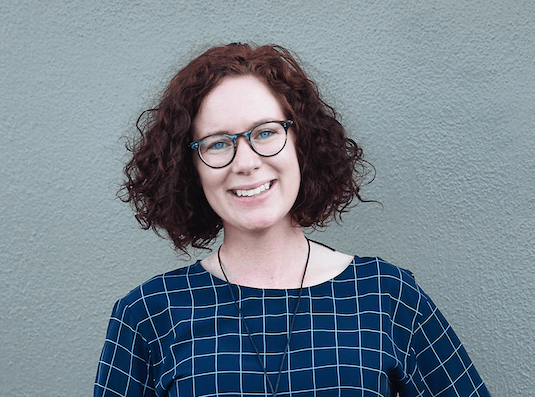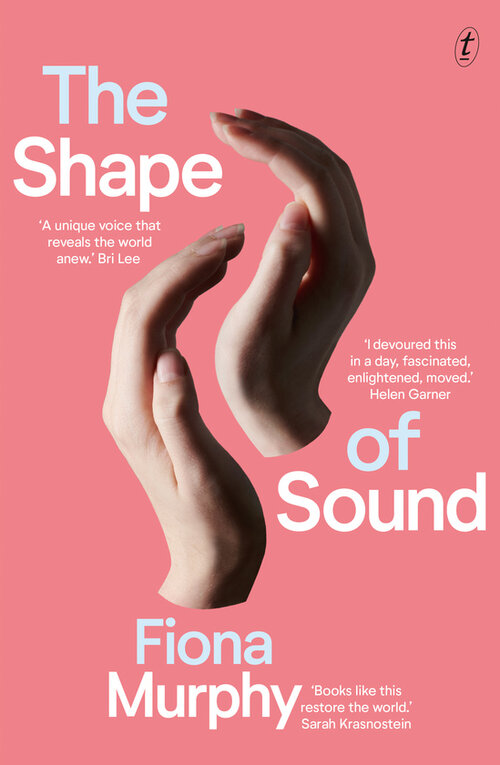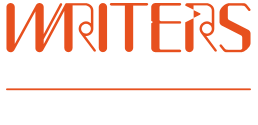
Fiona Murphy is an award-winning deaf poet and essayist based in the Blue Mountains, NSW. Her work has appeared in The Guardian, The Age, Kill Your Darlings, Overland, The Saturday Paper, Griffith Review, The Big Issue, among many other publications. Her debut memoir, The Shape of Sound, was released by Text Publishing in March 2021.
Fiona spoke to Writers Victoria intern Amy Bullow about her stunning debut The Shape of Sound and her thoughts on the process of putting together short and long-form work.
When did you first call yourself a ‘writer’? And what does that word mean to you?
I secretly considered myself a writer long before I had enough courage or conviction to tell anyone. Looking back, I can see that this was an important shift, as I had begun to act like one. I took the craft seriously and devoted more time to sitting at my desk. I started to submit work to publications and competitions. Eventually, after many rejections, my writing began to get published. This felt like the icing on the cake, as I had become invested in the process of writing rather than publication.
For me, being a writer is less about productivity or output, but how one approaches the world. I feel that a writer is someone who deeply considers language and story in whatever form. It doesn’t even have to be a conscious or analytical state, but really just a sense of curiosity. More often than not, I feel my most writerly when I’m reading a book. I start to ask myself: What is going to happen next? Why is that character so believable and compelling? How did the author create so much tension and narrative drive? Why is that paragraph so perfect?
You recently published your debut memoir, The Shape of Sound, with Text Publishing. What were your intentions behind writing your life story? And what did the planning and writing process look like for you?
Initially the manuscript wasn’t a memoir but was a collection of essays. It was never my intention to write about my life, I was far too committed to keeping my deafness a secret. And so, I began the project in a haphazard way—I wanted to know more about how other people experienced deafness. I was deeply curious about: hearing aids and audiology; sign language and Deaf culture; Deaf mental health; DeafSpace design and architecture; discrimination and employment opportunities; music and sound spaces. I spent about two years researching and writing, before I attempted to pull the material into a manuscript. It was honestly a red-hot mess. I retrospectively tried to plot and plan the book, yet nothing was holding the work together.
My editor, Penny Hueston, suggested that I turn the manuscript into a memoir structured in chronological order. At first, I rebelled against this recommendation—it seemed too straightforward, too simple! Once I started redrafting the manuscript, it became clear that a clear temporal structure created a sense of narrative propulsion. Eventually I could see how making it a memoir allowed me to use my curiosity as a narrative device. It gave me licence to pull in all the research I had discovered about deafness.
In your memoir, you retell a series of hardships you experienced throughout your life, particularly during your early years. Did you experience any difficulty or discomfort in writing such memoires? And if so, how did you combat these struggles?
There were definitely some sections that I wasn’t terribly excited writing about! I created a firm rule: every anecdote had to earn its keep. There needed to be a clear reason for including personal information, it would either have to propel the narrative along or help explain something.
To know whether an anecdote “worked” in the manuscript, I’d write an outline of the experience. I’d insert that rough thumbnail sketch into manuscript and keep working around it. Once I had finished a draft, I would reread the chapter and see if it had earned its place. Only then would I flesh out the memory in more detail or cut it. This process meant that I was still having to deeply reflect on my life experiences, but I wasn’t necessarily having to “relive” everything during the writing process.

Do you believe it’s a writer’s responsibility to represent a diverse array of experiences and voices? Is this something you actively think about as part of your process?
I do think it’s a writer’s responsibility to actively engage with the world, which includes incorporating a diverse range of experiences into a work. But the key word is “incorporating” rather than “representing”. I believe an author must know the inherent limitations of their experience and perception.
I’m passionate about Own Voices narratives. I think that someone’s lived experience gives them the authority—and by extension the authorial perspective—to truly represent that experience.
In my current novel in progress, my main character is a white woman who has hearing loss and tinnitus, which is an experience I know very well. But she works alongside people who have different ethnicities, socioeconomic backgrounds, genders, sexual orientations and disabilities. This way I’m reflecting the complexity of the world without trying to represent experiences that are not my own.
In an interview with the Australian Writers’ Centre, you recalled being “overwhelmed by ideas and not know[ing] where to begin…”. What advice would you give to a struggling young writer combatting these difficulties? And what advice would you perhaps give your younger self today?
I’m not sure if that’s a state that only emerging writers experience! I often feel overwhelmed, even if I’m just writing a 400-word book review! Though, I have become much more comfortable with allowing that feeling to become part of my writing process.
I tend to go through a few phases when I’m writing fiction or non-fiction:
- Brain dump: List down everything I know about the topic as well as everything I don’t know. I find lists much less intimidating than attempting to write sentences or paragraphs, it is sort of a quick way to banish the blank page!
- Project question: Once I’ve done a deep dive on the topic, I try to answer the question: Why am I writing this piece? Do I have a question to ask? Or do I have something to say? This becomes a touchstone throughout the project. Often, this process helps me identify the best form to work in (poem, short story, essay, book).
- Gather the material: This might be research material, quotes, sources of inspiration, lists of words I like, character traits, phrases and sentences that spring to mind. I tend to make a big messy document.
- Shape the material: Finally, I begin to write! During this phase I don’t bother making a clear delineation between writing and editing. I simply work with the material, adding and subtracting in an iterative process. If I feel lost or lacking motivation, I go back to my original list and project question. This will often reignite my sense of curiosity about the project.
- The final polish: I try to let a piece sit untouched for at least 24 hours before doing my final edits.
It helps me to think of writing as a series of phases. It removes the pressure of creating something amazing out of thin air. It also acknowledges that most projects, no matter how long, contain many moods: that initial surge of enthusiasm and curiosity; an inevitable waning of enthusiasm; fear disguised as boredom or procrastination; confusion and overwhelm.
I’ve become better at identifying which phase a project is in, and this allows me to plan my writing time accordingly. For instance, if I can’t focus and just want to procrastinate, I might work on the project that is currently in phase 3 (gather the material). But if I’m feeling clear eyed and decisive, I might focus my attention on a project that is currently in phase 4 (shaping the material) or phase 5 (the final polish). Mostly I’ve just become kinder to myself.
Do you have any exciting new projects you’re working on at the moment?
I’m working on a few non-fiction commissions ranging from book reviews, interviews and short feature articles. I really enjoy juggling several projects at once; it seems to suit my personality and temperament. On a practical level, it also fits around my fulltime day job.
I’m also working a psychological thriller based in regional NSW. The novel explores how medical students learn about life by studying death. If all goes to plan, I should be submitting the manuscript to my agent sometime over the summer.
Fiona’s memoir The Shape of Sound is available now in all good bookstores.
